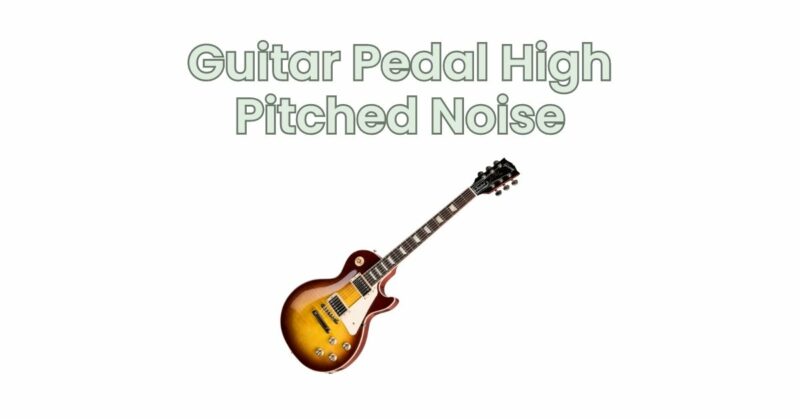A high-pitched noise emanating from your guitar pedal can be frustrating and distracting, interfering with the quality of your guitar tone. This type of noise can manifest as a squeal, whine, or piercing sound that is particularly noticeable when the pedal is engaged. In this article, we will explore the common causes behind high-pitched noise in guitar pedals, provide solutions to address the issue, and offer tips for reducing and eliminating unwanted noise, ensuring a clean and pleasant guitar signal.
Causes of High-Pitched Noise in Guitar Pedals:
- Power Supply Issues:
- Insufficient Power: Insufficient power from the power supply can cause the pedal to produce high-pitched noise. Make sure you’re using a power supply that provides adequate voltage and current for the pedal’s requirements.
- Ground Loop: A ground loop can occur when different components in your setup have different ground potentials. This can introduce noise into the signal chain, resulting in high-pitched noise. Using isolated power supplies or ground loop isolators can help minimize this issue.
- Environmental Factors:
- Radio Frequency Interference (RFI): Radio frequency interference from nearby electronic devices, such as mobile phones, computer monitors, or fluorescent lights, can induce high-pitched noise in your guitar pedal. Try moving your setup away from these potential sources of interference to reduce the noise.
- Pedal-Specific Issues:
- Poor Shielding: Inadequate shielding within the pedal can allow electromagnetic interference (EMI) to infiltrate the circuitry, leading to high-pitched noise. Shielding the pedal’s internal components or using shielded cables can help minimize EMI-related noise.
- Faulty Components or Wiring: Internal faults, such as loose connections, faulty components, or damaged wiring, can contribute to high-pitched noise. Inspecting the pedal’s circuitry and addressing any faulty or damaged components can resolve this issue.
Solutions and Tips for Reducing High-Pitched Noise:
- Power Supply Considerations:
- Use Isolated Power Supplies: Utilize isolated power supplies that provide clean and consistent power to your pedals. Isolated power supplies help prevent noise issues caused by power supply inadequacies or ground loops.
- Grounding and Shielding:
- Proper Grounding: Ensure that all components in your signal chain are properly grounded. This includes the guitar, pedals, amplifiers, and other devices. Ground loops can be minimized by using grounding techniques such as star grounding or ground lift adapters.
- Shielded Cables: Use high-quality shielded instrument cables and patch cables to minimize the effects of electromagnetic interference.
- Environmental Considerations:
- Interference-Free Placement: Position your setup away from potential sources of interference, such as electronic devices or electrical wiring. Experiment with different placement options to find the configuration that minimizes high-pitched noise.
- Pedal Maintenance:
- Internal Inspection: If you are comfortable working with electronics, inspect the pedal’s circuitry for loose connections, damaged components, or faulty wiring. Repair or replace any faulty components to eliminate high-pitched noise.
- Noise Reduction Pedals or Plugins:
- Consider Noise Reduction Pedals: Dedicated noise reduction pedals can effectively reduce unwanted noise in your signal chain. These pedals employ advanced algorithms to analyze and suppress noise while preserving your guitar’s tone.
- Software Noise Reduction Plugins: If you use a digital audio workstation (DAW), consider using noise reduction plugins to remove high-pitched noise during post-production or recording. These plugins can be particularly useful for addressing noise issues caused by pedals.
- Seek Professional Assistance:
- Consult Pedal Manufacturer: If you have tried the above solutions and the high-pitched noise persists, contact the pedal manufacturer for guidance or support. They may provide specific recommendations or troubleshooting advice.
- Visit a Qualified Technician: If the issue remains unresolved, consider seeking help from a qualified technician or guitar tech. They can diagnose and repair any internal circuitry issues that may be causing the high-pitched noise.
Conclusion:
Dealing with high-pitched noise in your guitar pedal can be bothersome, but with proper troubleshooting, most issues can be resolved. By addressing power supply concerns, grounding and shielding your setup, considering environmental factors, performing pedal maintenance, and utilizing noise reduction pedals or plugins, you can significantly reduce or eliminate high-pitched noise. If you are unable to resolve the issue on your own, consult the pedal manufacturer or seek professional assistance. With persistence and careful attention to troubleshooting steps, you can achieve a clean and noise-free guitar signal, allowing your tone to shine through without unwanted distractions.


